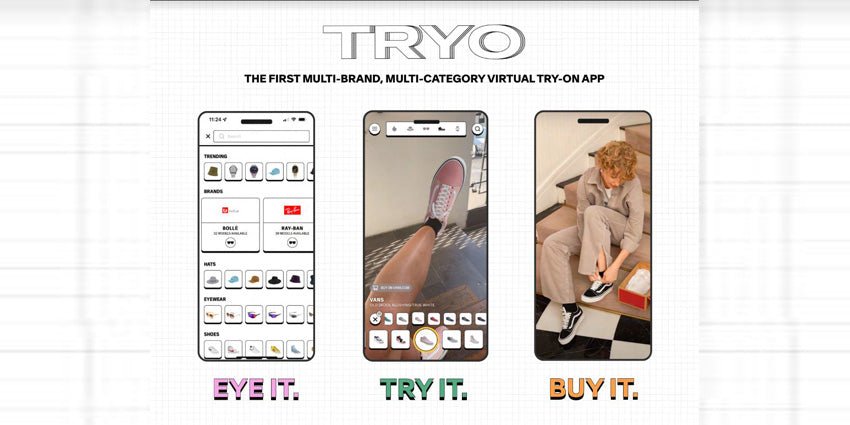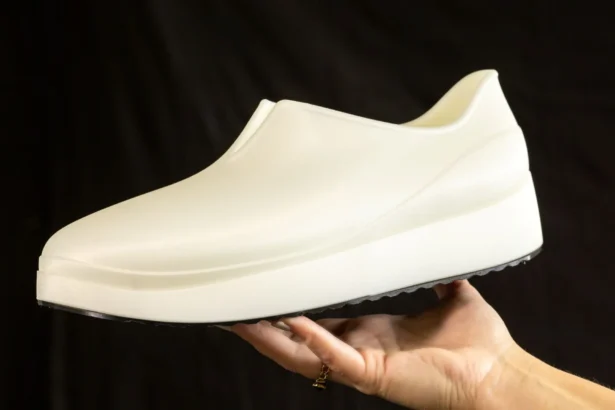
This Monday, The Glimpse Group subsidiary Qreal launched TRYO, a multi-brand, multi-category virtual try-on platform for smartphones. The service contains a vast library of 3D digital twins of real-life products from major clothing brands, which the firm updates weekly.
Clients can integrate TRYO as a website display, allowing users to access the virtual try-on platform without leaving the brand’s homepage. TRYO is also currently available for free on the Apple App Store.
TRYO’s launch partners include Cartier, Gucci, Adidas, and New Era. The service will also provide users with an endless aisle of digital items, including over 500 footwear, watches, hats, and eyewear goods. TRYO prioritizes 3D models to create an engaging visual shopping experience for users and a low-cost solution for retailers.
Mike Cadoux, the Co-Founder of TRYO, added: “Not only do we want to change the future of shopping and make it more fun and easy for consumers.”
According to the firm, the considerable upfront cost required for developing high-quality product digital twins slows the mass adoption of 3D extended reality (XR) retail solutions. Although, TRYO overcomes this with its low-cost 3D library and service.
Cadoux also added,
“We want to show brands how easy it could be to embed a virtual try-on experience into their own websites. It may seem like a daunting task, but we’re able to do it. TRYO shows it can be done”
Qreal is developing the TRYO platform. Previously, the augmented reality (AR) design firm worked with major immersive social media platforms like Snapchat and Instagram.
Benefits for Highstreet Retailers
Immersive try-on solutions provide a great investment for high-street merchants following hard economic times. XR retail and eCommerce technology can revolutionize the buyer’s journey with new immersive engagement opportunities.
Furthermore, a Snap study showed that shoppers participating in AR eCommerce and brand engagement avenues are 66 percent less likely to return purchased goods. The same study also showed that 96 percent of online shoppers are more likely to engage with additional AR features if present.
In an exclusive comment, Mike Cadoux explained how TRYO benefits high-street retailers,
“It’s challenging for High-street retailers to get the most out Virtual Try On technologies. They initially need to incur significant costs to create the 3D assets themselves, but then these assets are siloed into their own properties. TRYO seeks to standardize the assets themselves [file size, file type, 3D viewer, etc] and distribute a Universal 3D model to all their sales channels to disperse the costs to all who would benefit”
Furthermore, major retailers like Walmart are leveraging virtual try-on technologies. In September, Walmart added 270,000 clothing items to its immersive retail application for iOS.
Be Your Own Model by Walmart uses AI and machine learning algorithms to generate reactive and realistic digital items. Integrated neural networks empower Walmart developers to simulate fabric behaviour based on a user’s height and build.
Additionally, IKEA Kreativ is similar to virtual clothing try-on services. IKEA’s platform lets potential buyers place and preview AR digital twins of real-life interior design products in their homes by leveraging Apple’s LiDAR solution.
Leveraging ARKIT by Apple
The TRYO service also leverages ARKIT by Apple, thanks to a collaboration with the virtual try-on service Wanna Fashion. The partnership integrates Wanna Fashion’s motion tracking system [powered by ARKIT] into TRYO, enabling realistic watch and shoe try-on capabilities.
Apple’s ARKit is a sophisticated software development kit (SDK) that overlays 2D and 3D immersive elements in a real-world environment. The SDK allows XR application developers to create mobile services that leverage immersive features like motion tracking, camera passthrough, and image analysis.
Additionally, in a further comment provided by TRYO Co-Founder Cafoux, he noted the reasons why Qreal leveraged Apple’s ARKit, with assistance from Wanna Fashion,
“TRYO created their own face tracking technology, built on Apple’s ARKit. They evaluated the best solutions available and came to the conclusion that ARKit enables the highest FPS for a smoother experience, and enables them to anticipate future Apple releases”
He added the technology was used for “sunglasses and hat try-ons” and that for watches and shoes, his company used the “best technology around” and partnered with Wanna Fashion.
SOURCE: https://www.xrtoday.com/augmented-reality/qreal-launches-tryo-virtual-try-on-platform/




